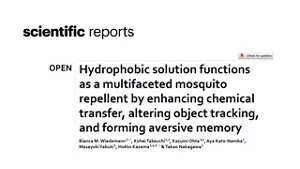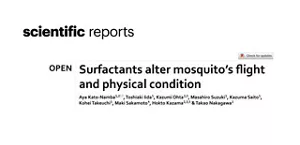Publications and Presentations

Sci. Rep. 14. 5422 (2024)
Abstract
Safe and effective mosquito repellents applicable to human skin are an important means to prevent the spread of mosquito-borne infectious diseases. In recent years, it has been confirmed that hydrophobic liquids such as low-viscosity polydimethylsiloxane (L-PDMS) can spread on the surface of human skin and prevent mosquito landing. This effect is attributed to the ability of L-PDMS to wet mosquito legs.
In this study, we newly identified three effects of L-PDMS on Aedes albopictus (the Asian tiger mosquito). First, when L-PDMS was mixed with conventional repellent ingredients such as citronella oil or DEET and applied to the skin, the silicone oil, owing to its ability to easily spread over mosquito legs, facilitated the transfer of these repellent ingredients to the legs and significantly enhanced their repellent effects. Second, when L-PDMS adhered to mosquito legs, it reduced their ability to track objects during flight. Third, when mosquitoes with L-PDMS and citronella oil applied to their legs were tested, their repellent behavior toward citronella oil was further enhanced.
These findings demonstrate that L-PDMS can alter mosquito behavior in multiple ways.
Table of Contents
Introduction
Results
- Enhancement of Repellent Effects by Combining L-PDMS with Repellent Ingredients
- Effects of L-PDMS on Mosquito Behavior
Discussion
Methods / References
Publication Details
- Title: Hydrophobic solution functions as a multifaceted mosquito repellent by enhancing chemical transfer, altering object tracking, and forming aversive memory
- Authors:Bianca M. Wiedemann, Kohei Takeuchi, Kazumi Ohta, Aya Kato-Namba, Masayuki Yabuki, Hokto Kazama, & Takao Nakagawa
- Journal: Scientific Reports
- Received: January 11, 2024
- Accepted: February 29, 2024
- Published: March 5, 2024
- DOI: 10.1038/s41598-024-55975-w

Sci. Rep. 13, 2355 (2023)
Abstract
Mosquitoes transmit diseases such as malaria and dengue fever, claiming hundreds of thousands of lives worldwide each year. Therefore, controlling mosquitoes is critically important; however, conventional insecticides present issues such as ecological impact and the development of insecticide resistance in mosquitoes. In this study, we explored the possibility of controlling mosquitoes without relying on insecticidal components, by using surfactants such as those found in detergents. Experiments were conducted on Aedes albopictus (the Asian tiger mosquito), focusing on solutions with low surface tension—particularly aqueous surfactant solutions—and analyzing how these liquids affect mosquito behavior by wetting their hydrophobic body surfaces. As a result, we found that when solutions with low surface tension attached to the body and wings of mosquitoes, the insects fell. Furthermore, as surface tension decreased, the mosquito body surface became wetted more quickly and extensively, leading not only to mosquitoes falling but also to their knockdown. These findings suggest that surfactants may provide a way to control mosquitoes without the need for conventional insecticidal components.
Table of Contents
Introduction
Results
- Aqueous Surfactant Solutions with Low Surface Tension Wet Mosquitoes and Cause Them to Fall
- Aqueous Surfactant Solutions Attached to the Body Impair Mosquito Flight
- Aqueous Surfactant Solutions with Even Lower Surface Tension Knock Down Mosquitoes
Discussion
Methods / References
Publication Details
- Title: Surfactants alter mosquito’s fight and physical condition
- Authors: Aya Kato‑Namba, Toshiaki Iida, Kazumi Ohta, Masahiro Suzuki, Kazuma Saito, Kohei Takeuchi, Maki Sakamoto, Hokto Kazama, Takao Nakagawa
- Journal: Scientific Reports
- Received: August 31, 2022
- Accepted: February 6, 2023
- Published: February 9, 2023
- DOI: 10.1038/s41598-023-29455-6
Abstract
Mosquito legs have a unique highly water-repellent surface structure. While being beneficial to mosquitoes, the water-repellence of the tarsi enhances the wettability of hydrophobic substances such as oils. This high wettability induces strong attraction forces on a mosquito’s legs (up to 87% of the mosquito’s weight) towards the oil. We studied the landing behaviour of mosquitoes on oil-coated surfaces and observed that the mosquito contact time was reduced compared to that on hydrophilic-liquid-coated surfaces, suggesting that the oil coating induces an escape response. The observed escape behaviour occurred consistently with several hydrophobic liquids, including silicone oil, which is used globally in personal care products. As the repellent effect is similar to multiple hydrophobic substances, it is likely to be mechanically stimulated owing to the physical properties of the hydrophobic liquids and not due to chemical interactions. On human skin, the contact time was sufficiently short to prevent mosquitoes from starting to blood-feed. The secretion of Hippopotamus amphibius, which has physical properties similar to those of low-viscosity silicone oil, also triggered an escape response, suggesting that it acts as a natural mosquito repellent. Our results are beneficial to develop new, safe, and effective mosquito-repellent technologies.
Table of Contents
Results
- Contact angle of various liquids on the legs of mosquitoes.
- Attractive force measurements.
- Behaviours of mosquitoes landing on hydrophobic liquids.
- Effect of PDMS viscosity and application ratio on contact time.
- Effect of PDMS viscosity on attractive capillary forces.
- Behaviours of mosquitoes landing on actual human skin.
Discussion
Methods/ Data availability/ References
Publication Details
- Title: Mosquito repellence induced by tarsal contact with hydrophobic liquids
-
Author: Hiroaki Iikura, Hiroyuki Takizawa, Satoshi Ozawa, Takao Nakagawa, Yoshiaki Matsui & Hiromi Nambu
(KAO Corporation, Material Science Research, and Personal Health Care Products Research) - Publishied: scientific reports
- Reception date: 7 April 2020
- Acceptance date: 14 August 2020
- Release date: 2 September 2020
- DOI: Sci. Rep. 10, 14480 (2020)
- Home
- Innovation
- Research & Development
- Research on Mosquito Behavior Control
- Publications and Presentations
- Home
- Innovation
- Research & Development
- Research on Mosquito Behavior Control
- Publications and Presentations

